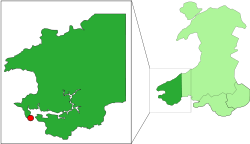
MV Sea Empress
Background to the schools Wikipedia
SOS Children made this Wikipedia selection alongside other schools resources. Click here for more information on SOS Children.
| Career | |
|---|---|
| Name: | Sea Empress |
| Owner: | Oriental Ocean Shipping |
| Builder: | |
| Acquired: | 2010 |
| Status: | Bulk carrier |
| General characteristics | |
| Displacement: | 147,273 DWT |
| Length: | 274.3 m (899.93 ft) |
| Beam: | 43.2 m (141.73 ft) |
| Draft: | 17.02 m (55.84 ft) |
| Propulsion: | direct-drive diesel, single propeller |
| Capacity: | 164,156 m3 (1,003,035.33 imp bbl) |
The MV Sea Empress was a single-hull oil tanker that ran aground near the southwest coast of Wales in February 1996. The ensuing oil spill affected a considerable area of nearby coastline. Pembrokeshire was suffering for over a year after the incident. Most of the birds in the area died and the oil made tourist-dependable beaches very ugly and black.
Grounding
On the evening of 15 February 1996 the Sea Empress was entering the mouth of the Cleddau Estuary on her way into Milford Haven in Pembrokeshire to deposit its foil cargo at the Texaco oil refinery. Sailing against the outgoing tide, at 20:07 UTC the ship was pushed off its course by the current, and hit rocks in the middle of the channel, which punctured her starboard hull causing oil to pour out into the bay.
Short-term effects
Over the first few days of the disaster an estimated 73,000 tonnes out of the ship's 130,000 tonne cargo of North Sea crude oil spilt onto the surrounding coast, causing a great deal of environmental and aesthetic damage to the coastline and its marine life and wildlife in an area which lies within the protection of the Pembrokeshire Coast National Park.
Birds
The most visible effect of the spill was seen in the large number of oil covered birds that were shown on television and in newspapers. Amongst the birds affected were guillemots, razorbills and the worst affected bird, the Common Scoter duck. 83% of the birds affected were Common Scoter birds, and it is estimated that 5000 of the 15000 population in the area were killed. The RSPB set up a temporary bird hospital in Milford Haven to try to treat as many birds as possible. This centre is now a storage area but in the aftermath of the Sea Empress disaster it became a hive of activity where many birds were showered and cleaned as best as possible. Unfortunately the life expectancy of a cleaned bird that was oiled once it was let back into the sea was a very short 9 days. Members of the public also helped rescue the birds. It was later revealed in a study by the British Trust for Ornithology that the average survival time for a rescued oiled bird was seven days.
Seals
Although the Sea Empress ran aground near to a breeding area for the grey seal, the time of year meant that only a minority of seals were in the area. Although some seals showed signs of oil on their coats, there is no record of a seal dying as a result of the spill.
Beaches
201 kilometers of coastline were covered in crude oil.
Long-term effects
The total cost of the cleanup operation was approximately £60 million
It took almost five years for the coastline to be fully cleaned up and restored by the Pembrokeshire Council and wildlife conservationists. There was much speculation in the media at the time over the fate and unreliability of old single hull tankers which had been the cause of another disaster in Scotland just a year earlier.
The Sea Empress was recovered and subsequently re-christened MV Sea Spirit. Later renamed MV Front Spirit, it was sold as MV Ocean Opal to Chinese buyers who used it as a floating storage and offloading unit (FSO) from 2004. In 2009/2010, she was converted in Shanghai into a bulk carrier, and reflagged as the Panamanian registered MV Welwind. In 2012, she was renamed for a fifth time and is currently known as Wind 3.

